-
Paper Information
- Next Paper
- Paper Submission
-
Journal Information
- About This Journal
- Editorial Board
- Current Issue
- Archive
- Author Guidelines
- Contact Us
International Journal of Instrumentation Science
p-ISSN: 2324-9994 e-ISSN: 2324-9986
2012; 1(5): 54-62
doi: 10.5923/j.instrument.20120105.01
Timing Applications to Improve the Energy Resolution of NaI(Tl) Scintillation Detectors
E. E. Ermis, C. Celiktas
Ege University, Faculty of Science, Physics Department, 35100, Bornova, Izmir, Turkey
Correspondence to: E. E. Ermis, Ege University, Faculty of Science, Physics Department, 35100, Bornova, Izmir, Turkey.
| Email: |  |
Copyright © 2012 Scientific & Academic Publishing. All Rights Reserved.
Gamma-ray energy resolution of a NaI(Tl) inorganic scintillation detector was improved in the present work. For this purpose, leading edge and constant fraction timing methods were used. Gamma energy spectrum of the radioisotope (137Cs) and the time spectra through these timing methods were obtained separately. Energy spectrum was gated with both time spectra, and the obtained results were compared with each other. Energy resolution enhancements of 3.5% and 7.5% on the photopeak of the radioisotope were obtained through leading edge and constant fraction timing methods, respectively. Energy resolution value from constant fraction timing was better than that of leading edge timing method.
Keywords: 137Cs, Leading Edge Timing Method, Constant Fraction Timing Method, Nai(Tl) Inorganic Scintillation Detector
Cite this paper: E. E. Ermis, C. Celiktas, "Timing Applications to Improve the Energy Resolution of NaI(Tl) Scintillation Detectors", International Journal of Instrumentation Science, Vol. 1 No. 5, 2012, pp. 54-62. doi: 10.5923/j.instrument.20120105.01.
Article Outline
1. Introduction
- The detection of ionizing radiation by the scintillation light produced in certain materials is one of the oldest techniques on record. The scintillation process remains one of the most useful methods available for the detection and spectroscopy of a wide assortment of radiations[1].In 1948, Robert Hofstadter first demonstrated that crystalline sodium iodide, in which a trace of thallium iodide had been added in the melt, produced an exceptionally large scintillation light output compared with the organic materials that had previously received primary attention.This discovery, more than any other single event, ushered in the era of modern scintillation spectrometry of gamma radiation [1].Most of the inorganic scintillators are crystals of the alkali metals, in particular alkali iodides, that contain a small concentration of an impurity[2]. The alkali halides are good scintillators. In addition to its efficient light yield, sodium iodide doped with thallium NaI(Tl) is almost linear in its energy response[3]. NaI(Tl)’s relatively high density (3.67x103 kg/m3) and high atomic number combined with the large volume make it a γ-ray detector with very high efficiency[2].In addition to detecting the presence of radiation, most detectors are also capable of providing some information on the energy of the radiation[4]. A particle energy spectrum is a function giving the distribution of particles in terms of their energies[2].The energy resolution of a detector (R) is conventionally defined as the full width at half maximum (FWHM) divided by the location of the peak centroid E0[1] (Fig. 1).
 | (1) |
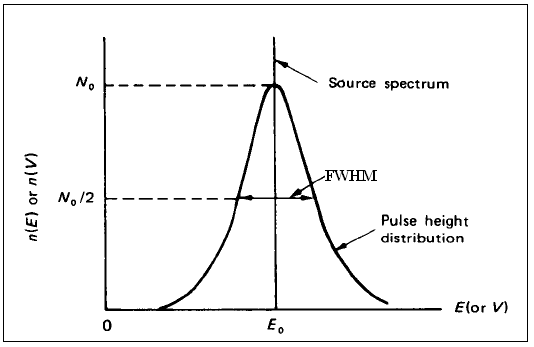 | Figure 1. Energy resolution of a detector[2] |
 | Figure 2. Time spectrum, definitions of shaping and peaking times[5] |
2. Experiments
- Leading edge timing method determines the time of arrival of a pulse with the help of a discriminator. A discriminator threshold is set and the time of arrival of the pulse is determined from the point where the pulse crosses the discriminator threshold[2].The principle of the leading edge timing method is shown in Fig. 3.
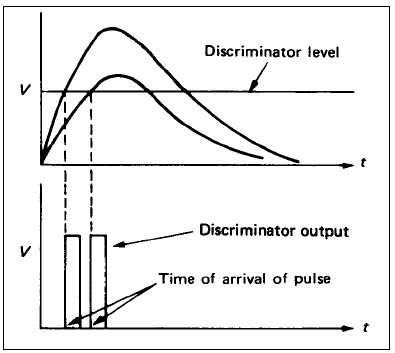 | Figure 3. The principle of the leading edge timing method[2] |
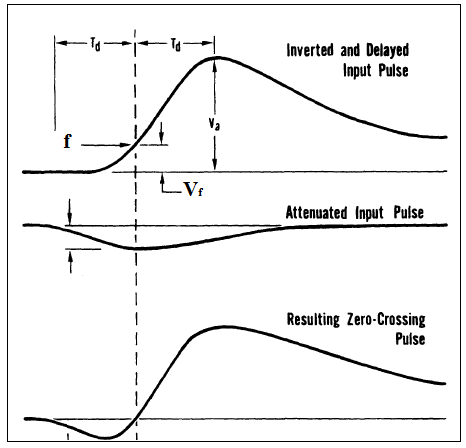 | Figure 4. Constant fraction timing method[15] |
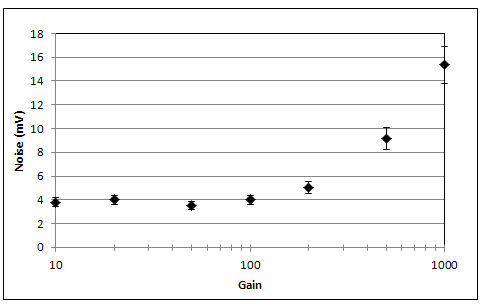 | Figure 5. Electronic noise vs. amplifier gain (detector bias= 1000 V) |
 | Figure 6. Time calibration graph |
 | Figure 7. Used spectrometer in leading edge timing method |
 | Figure 8. Block diagram of the used spectrometer in constant fraction timing method |
 | Figure 9. (a) TSCA (b) CFD output signal shapes |
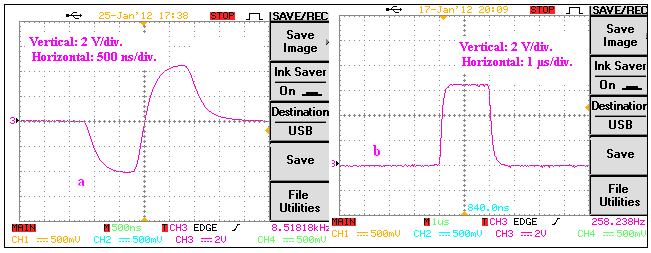 | Figure 10. (a) DLA bipolar (b) TAC output signal shapes |
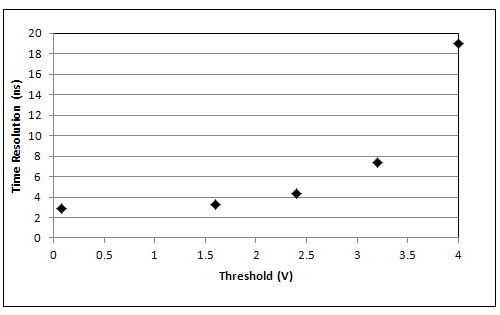 | Figure 11. Time resolution vs. CFD threshold |
 | Figure 12. Time resolution vs. delay |
3. Results and Discussions
- Background energy spectrum was recorded to consider its effect to the obtained energy spectra. Background energy spectrum is given in Fig. 13. Since the number of counts is quite low in comparison with the source energy spectrum, it can be deduced from this background spectrum that the background is not effective on the obtained energy spectra.
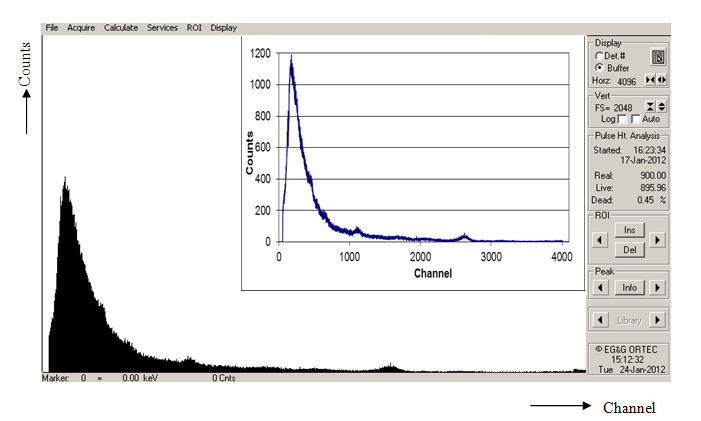 | Figure 13. Background energy spectrum |
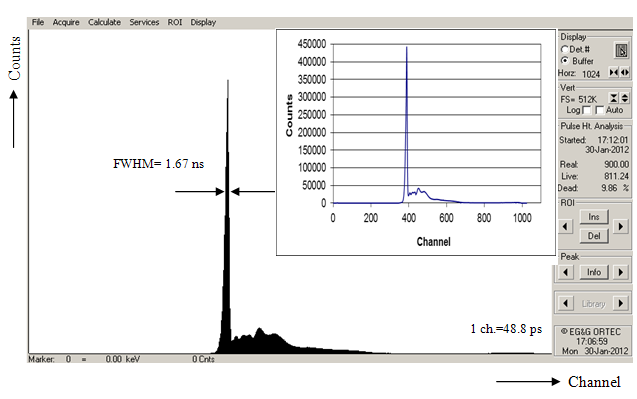 | Figure 14. Time spectrum of 137Cs by means of leading edge timing method |
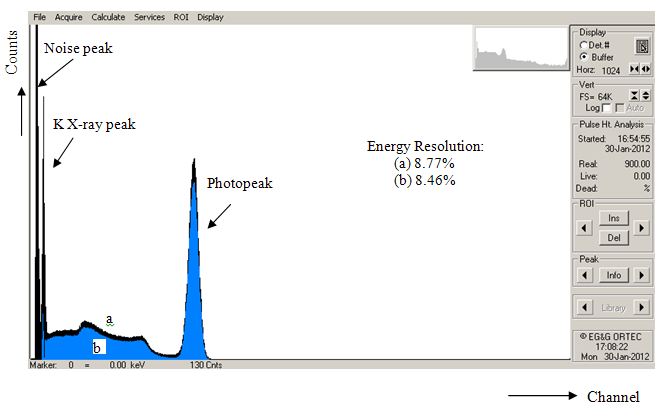 | Figure 15. Comparison of the energy spectra before (a) (black) and after (b) (blue) leading edge timing method |
 | Figure 16. Time spectrum of 137Cs by means of constant fraction timing method |
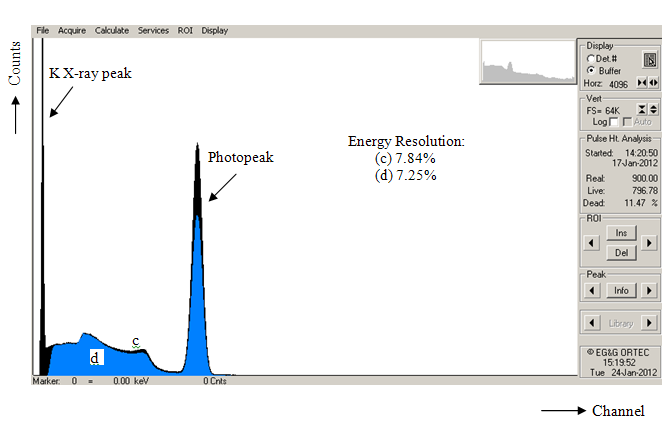 | Figure 17. Comparison of energy spectra before (c) (black) and after (d) (blue) constant fraction timing method |
4. Conclusions
- We aimed to improve the energy resolution of 137Cs energy spectrum of a NaI(Tl) inorganic scintillation detector in this study. Leading edge and constant fraction timing methods were used for this purpose. Obtained results showed that both methods can be used for the energy resolution enhancement of a NaI(Tl) scintillation detector.In the first timing method, energy resolution of the detector was calculated as 8.77% without any timing application. After application of the leading edge timing method, this value was decreased to 8.46% which corresponds to an improvement of 3.5%. In the second section of the work, the energy resolution value with constant fraction timing method was calculated as 7.25% while the value without constant fraction timing method was found as 7.84% which means that an energy resolution enhancement of 7.5% was obtained. It can be concluded from both results that the leading edge and the constant fraction timing methods can be used to improve the energy resolution of a NaI(Tl) scintillation detector. However, better energy resolution value was obtained by using constant fraction timing method than that of the leading edge method as indicated in various studies[15, 17].As a consequence of the obtained results, it can be concluded that these analog timing methods can be easily used for the energy resolution enhancement of any type of inorganic scintillation detector.
ACKNOWLEDGEMENTS
- This work was supported by TUBITAK, the Scientific and Technical Research Council of TURKEY under project numbers 197T087 and 111T571, and by EBILTEM, Center of Science and Technology, Ege University under project no. 99 BIL 001, and finally Scientific Research Foundation of Ege University under project no. 11 FEN 085.
 Abstract
Abstract Reference
Reference Full-Text PDF
Full-Text PDF Full-Text HTML
Full-Text HTML